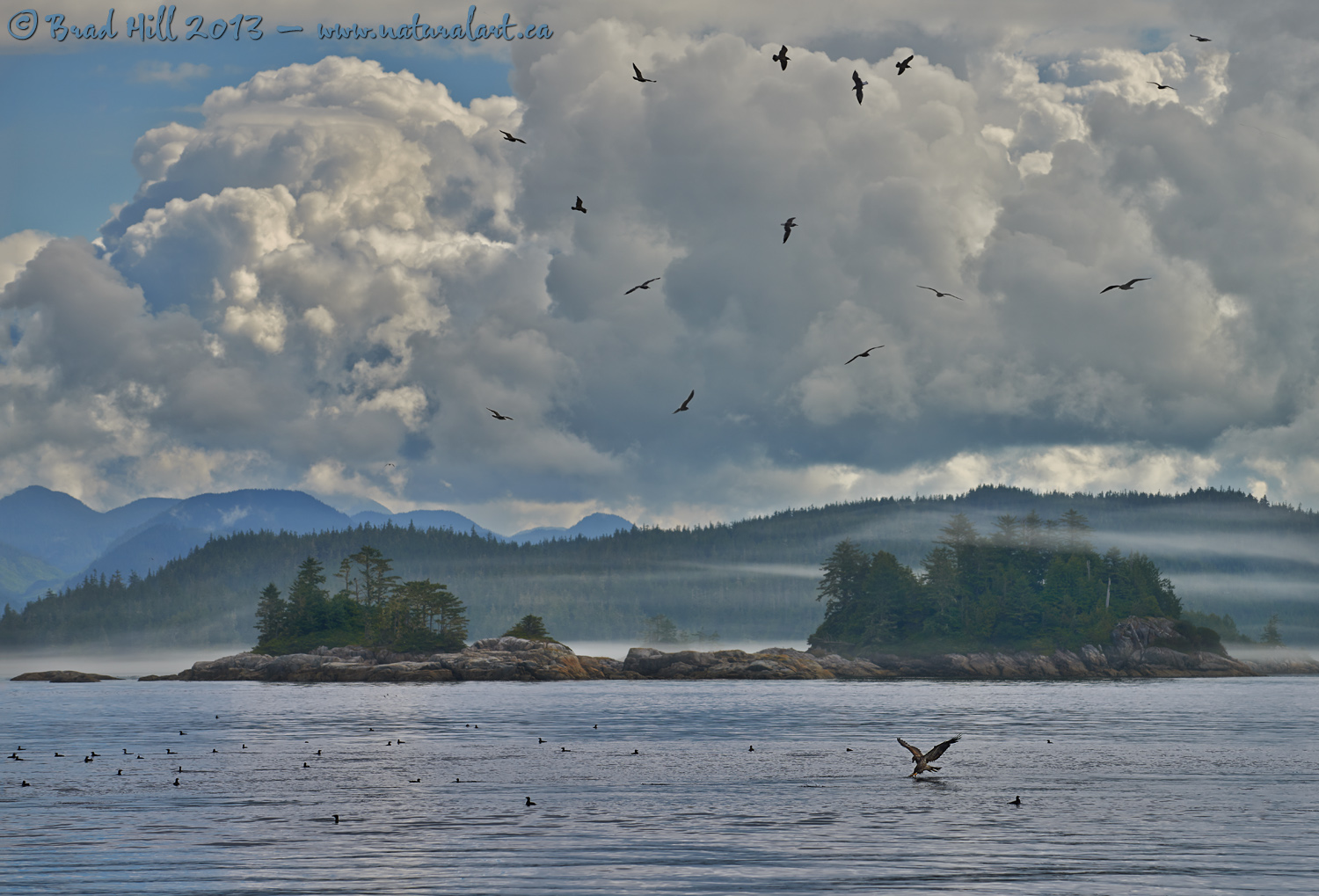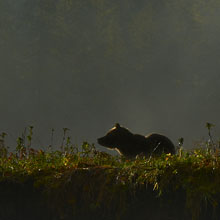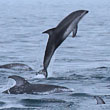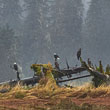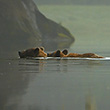Availability: Limited Edition Print - info coming soon!
In the Field
The Strike. Blackfish Sound (northern Vancouver Island, BC). August 19, 2013.
The coast of British Columbia is an amazing place, especially if you're a wildlife photographer. These days a portion of the coast known as The Great Bear Rainforest is getting all the headlines - and deservedly so, as it's in the eye of a huge storm of controversy surrounding the possible introduction of massive oil tankers into an area that is barely navigable by anything larger than a recreational boat (the sinking of the "Queen of the North" ferry on March 22, 2006 on the exact route the tankers are proposed to take illustrates this point well!). This image, however, was captured in a area near the northern tip of Vancouver Island that's not too far from the Great Bear Rainforest. Due to upwelling and the convergence of currents this region produces a lot of krill and other "bait fish" - and this food base supports a huge food chain on top of it. So, one finds a large variety (and large populations) of many species of aquatic mammals, as well as a large array of fish-eating birds. This shot depicts the organic richness of the area - the gulls (in the sky), Rhinoceros Auklets (on the water) and the eagle (striking the surface) are all feeding on a massive herring ball. While I was shooting this "birdscape" there was also 3 humpback whales feeding on the "bait" right behind me.
I like close-up shots of wildlife as much as the next wildlife photographer. But I also like the challenge of creating more expansive animalscapes* where the main subject is much smaller in the frame and just one part of, quite literally, the "big picture". I consider animalscapes among the toughest types of images to shoot - not only do you need to satisfy all the requirements of a good landscape shot, but you have to do it while incorporating wildlife (who rarely are keen to cooperate for you) doing what you what, where you want!
In this shot I was experimenting with something I have thought about many times - just how small can the subject be within the frame and still be instantly recognized as the main subject? I'm biased (because I shot this image and watched the scene unfold and have a distinct memory of it), but I'm pretty sure most viewers will be drawn to the eagle first, after which their eyes will start to explore the entire frame. So...I'm thinking that most would agree with me that the eagle IS the main subject here. And, if I'm right, it means that with good execution and composition, the main subject CAN occupy just a tiny portion of the frame (here it occupies less than one fifth of one percent of the image area) and still be considered the main subject. Those interested in wildlife photography but without the budget to afford those uber-expensive super-telephoto lenses should be rejoicing right now - this image was shot at 145mm (and with a lens that costs just a little over $1000).
One final comment...and generalization...about animalscapes: In my opinion the success of animalscapes depends largely on the rich detail they contain, and this detail is hard to convey unless the image is presented large. So...in most cases they work best as large prints (and are less effective when presented online, especially at small sizes). Until Nikon started producing DSLR's with a resolution exceeding 20 MP it was - in my opinion - hardly worth shooting animalscapes - the images simply didn't have the resolution to print large enough to make them work. While (at the time of this writing - autumn 2013) my favorite and "go-to" camera for wildlife work is definitely the D4, when I'm presented with a good animalscape I reach for either my D600 or, if I have it with me, my D800e.
For those looking for a hint of the detail found in the full resolution version of this image, here's a "medium" resolution (2400 pixel) version of the image!
• The Strike: Download 2400 pixel image (JPEG: 1.2 MB)
ADDITIONAL NOTES:
1. This image - in all resolutions - is protected by copyright. I'm fine with personal uses of it (including use as desktop backgrounds or screensavers on your own computer), but unauthorized commercial use of the image is prohibited by law. Thanks in advance for respecting my copyright!
2. Like all wildlife photographs on this website, this image was captured following the strict ethical guidelines described in The Wildlife FIRST! Principles of Photographer Conduct. I encourage all wildlife photographers to always put the welfare of their subjects above the value of their photographs.
3. This image was captured during my "Humpback, Orcas, Sea Lions & More" photo tour in August of 2013. Each year I offer trips into two different parts of the Great Bear Rainforest as well as one to photograph aquatic mammals and oceanscapes near the northern tip of Vancouver Island. And, in selected years, I also offer photo tours to locations to capture other highly sought-after subjects, such as various owl species of the boreal forest and wildlife of Canada's Arctic. Details about these trips can be found on the Photo Tours page of this website.
*4. For a discussion of the image types I call animalscapes and enviroscapes (and the subtle distinctions between them), just go here...
Behind the Camera
The Strike. Blackfish Sound (northern Vancouver Island, BC). August 19, 2013.
Digital Capture; Compressed RAW (NEF) 14-bit format; ISO 100.
Nikon D800e paired with Nikkor 70-200mm f4 VR lens @ 145mm. Circular polarizer used. Hand-held from sailboat - VR on (in "Normal" mode).
1/400s @ f8; no exposure compensation from matrix-metered exposure setting.
At the Computer
The Strike. Blackfish Sound (northern Vancouver Island, BC). August 19, 2013.
RAW Conversion to 16-bit TIFF, including first-pass/capture sharpening using Capture One Pro version 7. Three raw variants (different versions of a single raw capture) differing by a total of 0.5 stops in total exposure.
Further digital corrections on resulting 16-bit TIFF files using Adobe's Photoshop CC and Light Craft's LightZone. Photoshop adjustments included compositing (blending) of the three exposure variants, minor selective colour saturation and desaturation, and selective contrast adjustment (using selectively applied tone curve adjustment layers) and sharpening for web output. Final tone tweaking performed using tonemapper/re-light tool in LightZone.
Conservation
The Strike. Blackfish Sound (northern Vancouver Island, BC). August 19, 2013.
Ten percent of the revenue generated by this image will be donated to Raincoast*.
Species Status in Canada**: None of the wildlife in this image are currently considered under threat or endangered with extinction.
While none of the species shown in this image are currently threatened with extinction, the region this image was shot in is, at the time of this writing (November 12, 2013), facing a new and potentially catastrophic threat. There is a proposal to bring oil super-tankers through the narrow and treacherous channels of the Great Bear Rainforest and nearby regions, including the region this image was shot in. Any mishap - such as the one that sunk the Queen of the North ferry on March 22, 2006 - could result in an oilspill with disasterous consequences.
*The Raincoast Conservation Society (and Foundation) is an effective and efficient organization that has been fighting for protection of this unique habitat. If you are looking for a meaningful way to contribute to the conservation of this amazing ecosystem, Raincoast will provide maximal "bang" for your conservation dollars.
**as determined by COSEWIC: The Committee on the Status of Endangered Wildlife in Canada













